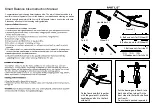
66
67
PART II
SECTION D.
INSPECT FOR SAFETY
In this section, we will do our best to outline some
material science basics and explain how they relate
to your bicycle, some of the trade offs made in
designing your bicycle, what you can expect from
your bicycle and provide important, basic guidelines
on how you maintain and inspect it.
Carbon fiber bikes and components are becoming
more common.
In addition to 2. Understanding Composites (Carbon
Fiber) in this section, see also:
APPENDIX A, page 88
APPENDIX C, page 90.
APPENDIX D, page 94.
APPENDIX E, page 98
APPENDIX F, page 100
WARNING
FREQUENT INSPECTION OF YOUR BIKE IS
IMPORTANT TO YOUR SAFETY. FOLLOW THE
PRE-RIDE CHECKLIST BEFORE EVERY RIDE.
See the back cover of this manual.
Periodic, more detailed inspection of your bicycle
is important. How often this more detailed
inspection is needed
depends upon you.
You, the rider/owner, have control and
knowledge of how often you use your bike, how
hard you use it and where you use it. Cannondale
does not. We design rugged and light bicycles
and test them extensively. But, because we
cannot track your use, you must be responsible
for inspection and maintenance. Most
customers will have a retailer do all inspection
and maintenance.
If you are not interested in the “hands on”
aspects of your bicycle, and do not wish to
perform inspection or maintenance on your own
bike, then you must make your retailer a partner
in maintaining and inspecting your bicycle. Work
with your retailer to determine a maintenance
and inspection schedule appropriate for your
riding. PART I, SECTION 5. A provides some
general guidelines on service intervals.
For your safety, understanding and
communication with your retailer, we urge you to
read this section. The materials used to make
your bike determine how to inspect it properly.
YOU CAN BE SEVERELY INJURED, PARALYZED,
OR KILLED IF YOU IGNORE THIS WARNING.
















































